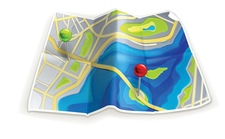Read and process GPS data
Data On the Go

© Lead Image © Nataliia Natykach, 123RF.com
Almost all manufacturers of GPS devices use proprietary formats to save routes, tracks, and waypoints. Vendors unfortunately rarely offer Linux software for uploading and downloading or processing the data. Four GPS editors keep Linux users on the right track.
Most smartphones have a GPS receiver, and handheld GPS devices, sports watches, and bike computers are available today at budget prices. These practical devices can simplify navigation, find geocaches, and record tours with your speed, distance covered, elevation, calories burned, and much more. With a chest strap, training computers can also measure your pulse.
If you want to analyze the data later on your PC or show it to family and friends, you first need to transfer the logs to your computer. A software tool helps you evaluate and rework the raw data.
Many outdoor enthusiasts like to plan their hiking, cycling, and running routes in advance. On the web are many portals where users can compose tours online and then download the results. The community also exchanges data and more on sites like GPSies [1], GPS-Tour.info [2], BikeNet [3], Outdoor Active [4], ShareMyRoutes [5], and EveryTrail [6]. A breakdown of features offered by various GPS editors is shown in Table 1.
[...]
Buy this article as PDF
(incl. VAT)
Buy Linux Magazine
Subscribe to our Linux Newsletters
Find Linux and Open Source Jobs
Subscribe to our ADMIN Newsletters
Support Our Work
Linux Magazine content is made possible with support from readers like you. Please consider contributing when you’ve found an article to be beneficial.

News
-
Parrot OS Switches to KDE Plasma Desktop
Yet another distro is making the move to the KDE Plasma desktop.
-
TUXEDO Announces Gemini 17
TUXEDO Computers has released the fourth generation of its Gemini laptop with plenty of updates.
-
Two New Distros Adopt Enlightenment
MX Moksha and AV Linux 25 join ranks with Bodhi Linux and embrace the Enlightenment desktop.
-
Solus Linux 4.8 Removes Python 2
Solus Linux 4.8 has been released with the latest Linux kernel, updated desktops, and a key removal.
-
Zorin OS 18 Hits over a Million Downloads
If you doubt Linux isn't gaining popularity, you only have to look at Zorin OS's download numbers.
-
TUXEDO Computers Scraps Snapdragon X1E-Based Laptop
Due to issues with a Snapdragon CPU, TUXEDO Computers has cancelled its plans to release a laptop based on this elite hardware.
-
Debian Unleashes Debian Libre Live
Debian Libre Live keeps your machine free of proprietary software.
-
Valve Announces Pending Release of Steam Machine
Shout it to the heavens: Steam Machine, powered by Linux, is set to arrive in 2026.
-
Happy Birthday, ADMIN Magazine!
ADMIN is celebrating its 15th anniversary with issue #90.
-
Another Linux Malware Discovered
Russian hackers use Hyper-V to hide malware within Linux virtual machines.

